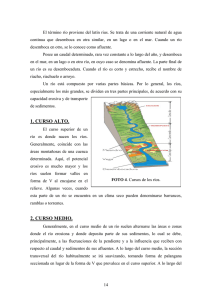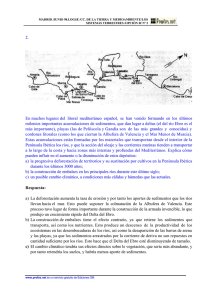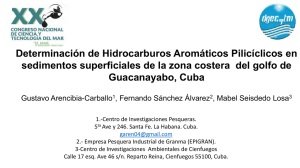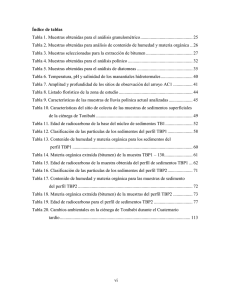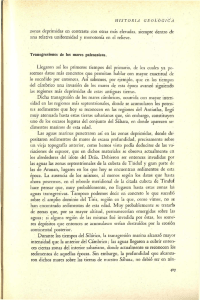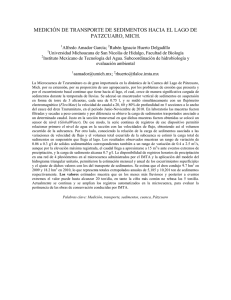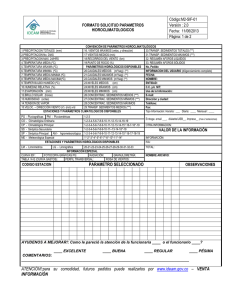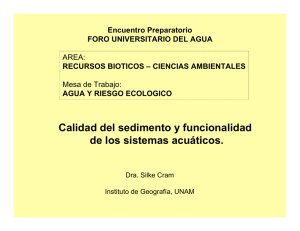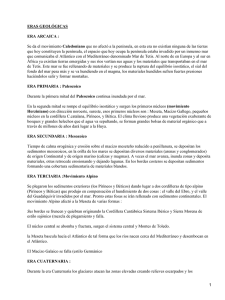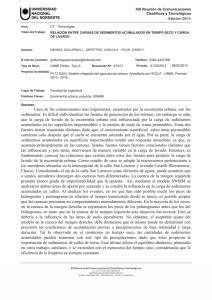Toxicity assays of marine sediments from western Venezuela
Anuncio
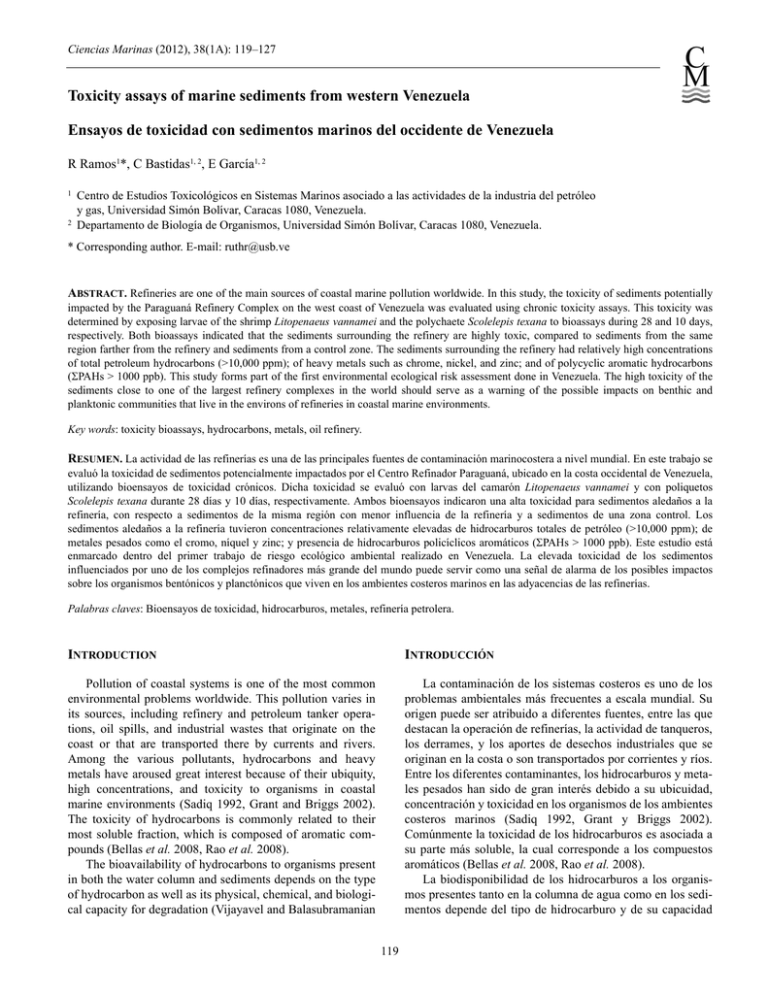
Ciencias Marinas (2012), 38(1A): 119–127 Toxicity assays of marine sediments from western Venezuela C M Ensayos de toxicidad con sedimentos marinos del occidente de Venezuela R Ramos1*, C Bastidas1, 2, E García1, 2 1 2 Centro de Estudios Toxicológicos en Sistemas Marinos asociado a las actividades de la industria del petróleo y gas, Universidad Simón Bolívar, Caracas 1080, Venezuela. Departamento de Biología de Organismos, Universidad Simón Bolívar, Caracas 1080, Venezuela. * Corresponding author. E-mail: ruthr@usb.ve ABSTRACT. Refineries are one of the main sources of coastal marine pollution worldwide. In this study, the toxicity of sediments potentially impacted by the Paraguaná Refinery Complex on the west coast of Venezuela was evaluated using chronic toxicity assays. This toxicity was determined by exposing larvae of the shrimp Litopenaeus vannamei and the polychaete Scolelepis texana to bioassays during 28 and 10 days, respectively. Both bioassays indicated that the sediments surrounding the refinery are highly toxic, compared to sediments from the same region farther from the refinery and sediments from a control zone. The sediments surrounding the refinery had relatively high concentrations of total petroleum hydrocarbons (>10,000 ppm); of heavy metals such as chrome, nickel, and zinc; and of polycyclic aromatic hydrocarbons (PAHs > 1000 ppb). This study forms part of the first environmental ecological risk assessment done in Venezuela. The high toxicity of the sediments close to one of the largest refinery complexes in the world should serve as a warning of the possible impacts on benthic and planktonic communities that live in the environs of refineries in coastal marine environments. Key words: toxicity bioassays, hydrocarbons, metals, oil refinery. RESUMEN. La actividad de las refinerías es una de las principales fuentes de contaminación marinocostera a nivel mundial. En este trabajo se evaluó la toxicidad de sedimentos potencialmente impactados por el Centro Refinador Paraguaná, ubicado en la costa occidental de Venezuela, utilizando bioensayos de toxicidad crónicos. Dicha toxicidad se evaluó con larvas del camarón Litopenaeus vannamei y con poliquetos Scolelepis texana durante 28 días y 10 días, respectivamente. Ambos bioensayos indicaron una alta toxicidad para sedimentos aledaños a la refinería, con respecto a sedimentos de la misma región con menor influencia de la refinería y a sedimentos de una zona control. Los sedimentos aledaños a la refinería tuvieron concentraciones relativamente elevadas de hidrocarburos totales de petróleo (>10,000 ppm); de metales pesados como el cromo, níquel y zinc; y presencia de hidrocarburos policíclicos aromáticos (PAHs > 1000 ppb). Este estudio está enmarcado dentro del primer trabajo de riesgo ecológico ambiental realizado en Venezuela. La elevada toxicidad de los sedimentos influenciados por uno de los complejos refinadores más grande del mundo puede servir como una señal de alarma de los posibles impactos sobre los organismos bentónicos y planctónicos que viven en los ambientes costeros marinos en las adyacencias de las refinerías. Palabras claves: Bioensayos de toxicidad, hidrocarburos, metales, refinería petrolera. INTRODUCTION INTRODUCCIÓN Pollution of coastal systems is one of the most common environmental problems worldwide. This pollution varies in its sources, including refinery and petroleum tanker operations, oil spills, and industrial wastes that originate on the coast or that are transported there by currents and rivers. Among the various pollutants, hydrocarbons and heavy metals have aroused great interest because of their ubiquity, high concentrations, and toxicity to organisms in coastal marine environments (Sadiq 1992, Grant and Briggs 2002). The toxicity of hydrocarbons is commonly related to their most soluble fraction, which is composed of aromatic compounds (Bellas et al. 2008, Rao et al. 2008). The bioavailability of hydrocarbons to organisms present in both the water column and sediments depends on the type of hydrocarbon as well as its physical, chemical, and biological capacity for degradation (Vijayavel and Balasubramanian La contaminación de los sistemas costeros es uno de los problemas ambientales más frecuentes a escala mundial. Su origen puede ser atribuido a diferentes fuentes, entre las que destacan la operación de refinerías, la actividad de tanqueros, los derrames, y los aportes de desechos industriales que se originan en la costa o son transportados por corrientes y ríos. Entre los diferentes contaminantes, los hidrocarburos y metales pesados han sido de gran interés debido a su ubicuidad, concentración y toxicidad en los organismos de los ambientes costeros marinos (Sadiq 1992, Grant y Briggs 2002). Comúnmente la toxicidad de los hidrocarburos es asociada a su parte más soluble, la cual corresponde a los compuestos aromáticos (Bellas et al. 2008, Rao et al. 2008). La biodisponibilidad de los hidrocarburos a los organismos presentes tanto en la columna de agua como en los sedimentos depende del tipo de hidrocarburo y de su capacidad 119 Ciencias Marinas, Vol. 38, No. 1A, 2012 física, química y biológica de degradación (Vijayavel y Balasubramanian 2006). Por otra parte, cada sistema marino costero tiene características particulares que afectan el comportamiento de estos compuestos contaminantes. Las refinerías presentes en la zona noroeste de Venezuela procesan un alto volumen de barriles de hidrocarburos diariamente (940.000 barriles) y operan desde hace 60 años, por lo que los sedimentos aledaños a estas refinerías pueden considerarse impactados debido a que presentan una alta concentración de compuestos como hidrocarburos totales (>10,000 ppm), hidrocarburos policíclicos aromáticos (>1000 ppb) y metales como Cd (2.52 ppm), Cr (25 ppm), Zn (34 ppm) y Ni (13.33 ppm) (García 2007). Las concentraciones de estos últimos generalmente son mayores que las registradas como capaces de producir efectos en la biota (Efecto de bajo rango, Long et al. 1995). Asimismo, estos sedimentos se caracterizan por tener una relación entre metales pesados y ácidos sulfúricos volátiles >1 (García 2007), lo que hace a los elementos metálicos más biodisponibles para la biota y, por tanto, potencialmente más tóxicos (Di Toro et al. 1992). Desde 2005 se ha monitorizado ambientalmente la franja costera aledaña (~30 km) al Complejo Refinador de Paraguaná mediante la medición de parámetros ambientales de la columna de agua y los sedimentos (e.g., metales, hidrocarburos, sólidos, sulfuros ácidos volátiles) en 20 estaciones, cuatro veces al año. Esto ha permitido identificar áreas con diferente grado de impacto por la actividad de la refinería (García 2011). Con base en esta información, en este trabajo evaluamos el efecto de los sedimentos impactados por las actividades del Complejo Refinador Paraguaná sobre la biota, utilizando ensayos de toxicidad crónicos con dos tipos de organismos característicos del área de estudio y presentes en la columna de agua y en los sedimentos. 2006). In addition, each coastal marine system has its own particular characteristics that affect the behavior of these contaminant compounds. The refineries in northwestern Venezuela process a large volume of barrels of hydrocarbons daily (940.000) and have been operating for 60 years. The sediments surrounding these refineries can be considered to be impacted as they contain high concentrations of toxic compounds such as total hydrocarbons (>10,000 ppm), polycyclic aromatic hydrocarbons (>1000 ppb), and metals like Cd (2.52 ppm), Cr (25 ppm), Zn (34 ppm), and Ni (13.33 ppm) (García 2007). Metal concentrations are generally higher than the threshold concentrations above which the biota is affected (Effects Range-Low, Long et al. 1995). Moreover, these sediments are characterized by having a >1 relation between heavy metals and acid volatile sulfides (García 2007), which indicates the availability of these metal elements to the biota, thus making them potentially more toxic (Di Toro et al. 1992). Since 2005 we have monitored the coastal environment in the vicinity (~30 km) of the Paraguaná Refinery Complex by measuring water and sediment quality (e.g., metals, hydrocarbons, total suspended solids, acid volatile sulfides) at 20 sites four times a year. This has allowed the identification of areas with different degree of impact, likely due to the refinery activities (García 2011). Based on this information, in this study we evaluated the effect of the sediments impacted by the activities of the Paraguaná Refinery Complex on the biota, using chronic toxicity assays with two types of organisms characteristic of the study area that occur in the water column and the sediments. MATERIAL AND METHODS The water column assay was done with larvae of the shrimp Litopenaeus vannamei, which were commercially obtained in the PL10 developmental phase and acclimatized during three days under laboratory conditions in seawater filtered through Millipore filters (0.45 m). The assay lasted 28 days and three substrate types were used: (1) nonimpacted sediments (NIS), extracted from the north coast of Paraguaná where the refinery has little influence; (2) impacted sediments (IS), extracted from beaches surrounding the refinery that receive industrial wastes; and (3) control sediments (CS), from a sandy beach more than 200 km east of the refinery (fig. 1). The degree of sediment contamination or impact was based on García (2007). The sediments for the bioassays were collected with a grab at three sites with each of the three types of sediments, and they were refrigerated at 4 ºC. For the bioassays, sediments were sieved (500 m) twice for homogenization and macrofaunal removal. Control sediments were sand-muddy with 0.6% total organic carbon (TOC) and 2.8% organic matter (OM), NIS were medium-size grain sands with 0.3% TOC and 3% OM, and IS were mud-sandy with 2.1% TOC and 14.3% OM. MATERIALES Y MÉTODOS El ensayo con organismos de la columna de agua se realizó con larvas del camarón Litopenaeus vannamei, que fueron obtenidas comercialmente en el estadio PL10 y aclimatadas durante tres días en condiciones de laboratorio con agua de mar filtrada con filtros Millipore (0.45 m). Para este ensayo de 28 días de duración, se utilizaron tres tipos de sedimentos: (1) sedimentos “no impactado” (SNI), extraído de la costa norte de Paraguaná, donde la refinería tiene poca influencia; (2) sedimento “impactado” (SI), extraído de las playas aledañas a la refinería que reciben las descargas industriales; y (3) sedimento control (SC), proveniente de una playa arenosa a más de 200 km al este de la refinería (fig. 1). El grado de contaminación o impacto de los sedimentos fue definido con base en García (2007). Los sedimentos fueron tomados con draga en tres sitios con cada uno de estos tres tipos de sedimento y, posteriormente, fueron refrigerados a 4 ºC. Para los ensayos, los sedimentos fueron tamizados (500 m) dos veces hasta tener una matriz homogénea y libre de macrofauna. Los SC eran areno-fangosos con 120 Ramos et al.: Toxicity assays of marine sediments from Venezuela 70°20’ W 70° 15’ 70° 10’ Las Tre Non Impacted s María 71° 00’ 70° 30’ 70° 00’ a s Caribbean Sea 12° 00’ 11° 50’ Paraguaná Peninsula Las Taques Gulf de Venezuela Jayana Golfete de Coro 11° 30’ Amuay b Judibana 0 20 40 km Gu ara n ao 11° 45’ 20 11° 40’ Caribbean Sea a Punto Fijo 12° Gulf de Venezuela Playa Tucacas Punta Cardón N 7° Venezuela 11° 35’ S Impacted 3 0 3 6 km 200 b 0 200 71° 400 km 66° 61° Figure 1. Map of the study area and location of the site where the control sediments were taken (Playa Tucacas). (a) Paraguaná region. (b) Location of oil refineries and sites considered impacted and non-impacted. Figura 1. Mapa del área de estudio, y sitio de donde provinieron los sedimentos control (Playa Tucacas). (a) Detalle de la Región de Paraguaná. (b) Ubicación de las Refinerías de la zona y de la zona considerada impactada y no impactada. 0.6% carbono orgánico total (COT) y 2.8% materia orgánica (MO), los SNI eran arenas medias con 0.3% COT y 3% MO, y los SI eran fango-arenosos con 2.1% COT y 14.3% MO. En el bioensayo se usaron dos factores fijos: tipo de sedimento (SNI y el SI) y su proporción en la mezcla (i.e., 0%, 10%, 25%, 50% y 100%). En cada una de las 10 combinaciones resultantes (o tratamientos), la parte restante de la mezcla de sedimentos provino del SC; por ejemplo, 10% de SNI se mezcló con un 90% del SC. Cuando la proporción fue del 0%, todos los sedimentos usados provinieron del sitio control. Cada tratamiento se realizó en tres contenedores de vidrio (réplicas). En cada réplica se usaron 20 larvas en un volumen de 500 mL de agua de mar filtrada y con 100 g de la mezcla de sedimentos. Cada contenedor tenía aireación continua para facilitar la resuspensión de sedimentos, y las larvas fueron alimentadas diariamente con Artemia salina. Para el bioensayo con organismos bentónicos, los individuos del poliqueto Scolelepis texana fueron recolectados en el campo, en el sitio control. Para asegurar el uso de adultos, el tamaño de estos organismos en el bioensayo osciló de 0.5 a 1 cm. Los poliquetos fueron aclimatados a las condiciones de laboratorio durante tres días antes del inicio del bioensayo. There were two fixed factors in the bioassay: type of sediment (NIS and IS) and its proportion in the mixture (i.e., 0%, 10%, 25%, 50%, and 100%). In each of the resulting 10 combinations (or treatments), the remaining portion of the sediment mixture came from the CS; for example, 10% of NIS was mixed with 90% of CS. When the proportion was 0%, all the sediment used came from the control site. Each treatment was performed in three glass containers (replicates). Each replicate contained 20 larvae in 500 mL of filtered seawater and 100 g of the sediment mixture. Each replicate had continuous aeration to facilitate sediment resuspension and Artemia salina were added daily to feed the larvae. Individuals of the polychaete Scolelepis texana were collected from the field at the control site for the bioassay with benthic organisms. To ensure the use of adults, the size of these organisms ranged from 0.5 to 1 cm. Polychaetes were acclimated to laboratory conditions for three days prior to the initiation of the bioassay. In this case, there were three treatments with the same types of sediments as those used for the bioassay with larvae: 100% CS, 100% NIS, and 100% IS. The bioassay had a 10-day duration, and each replicate 121 Ciencias Marinas, Vol. 38, No. 1A, 2012 En este caso, habían tres tratamientos con el mismo tipo de sedimento que se utilizó en el bioensayo con larvas: 100% SC, 100% SNI y 100% SI. El bioensayo tuvo una duración de 10 días, y cada réplica contenía 20 individuos, 200 g de sedimento y 400 mL de agua de mar filtrada. Cada tratamiento consistió en cinco réplicas (en lugar de tres que se utilizaron para las larvas). Para ambos bioensayos, las características fisicoquímicas del agua de cada uno de los acuarios (temperatura, salinidad, oxígeno disuelto y pH) fueron medidas diariamente con sondas Hanna (HI 991301 y HI 9143). Dichas variables del agua de los acuarios se mantuvieron constantes y similares entre los tratamientos tanto para el bioensayo con larvas de camarón como para el de poliquetos (tabla 1). Sólo en el ensayo con poliquetos se midió la concentración de amonio (paquete de prueba API). Al culminar cada ensayo, se determinó el porcentaje de supervivencia del organismo, y se tomaron muestras de los sedimentos de cada acuario para determinar la concentración de hidrocarburos totales de petróleo (TPH, por sus siglas en inglés), hidrocarburos policíclicos aromáticos (PAH) y metales. La concentración de TPH se realizó según el método EPA 1664 (US EPA 2000), pero con una modificación del solvente utilizado: una mezcla de 50:50 acetona:hexano. Para determinar la concentración de PAH, se realizó la extracción de las muestras con hexano:éter (80:20) y la detección por cromatografía de gases (GC Chrompack CP 9001), con columna de capilar sílica fundida CB-5, inyector Splitter (3 mL min–1, 230 ºC), detector FID (250 ºC) y hexano como solvente. La concentración de Cd, Pb, Cr, Ni y Zn se midió por el método EPA 3051-200.7; la digestión se hizo con HNO3 en un microondas (Milestone Ethos Touch control) y la detección de los elementos con espectroscopía de emisión óptica de plasma acoplado inductivamente (ICP-OES, Optima 2100 DV, PerkinElmer). La concentración de mercurio se midió por el método EPA-7470 de fluorescencia atómica (US EPA 2005), y las muestras fueron digeridas con aqua regia, permanganato de potasio (5%), hidroxilamina (1.5%) y cloruro de estaño (10%). El contenido de mercurio se midio por contained 20 individuals, 200 g of sediment, and 400 mL of filtered seawater. Each treatment consisted of five replicates (instead of three as used for the larvae). For both bioassays, the physico-chemical characteristics of the water in each aquarium (temperature, salinity, dissolved oxygen, and pH) were measured daily with Hanna probes (HI 991301 and HI 9143). These water variables were maintained constant and similar in all the aquariums used for both the shrimp and polychaete assays (table 1). Only in the polychaete test was ammonia concentration measured (API test kit). At the end of each assay, the survival percentage of each organism was noted, and sediment samples were taken from each aquarium in order to determine the concentrations of total petroleum hydrocarbons (TPHs), polycyclic aromatic hydrocarbons (PAHs), and metals. The concentration of TPHs was determined using EPA Method 1664 (US EPA 2000), but with a modification of the solvent used: a mixture of 50:50 acetone:hexane. To determine the concentration of PAHs, the samples were extracted with hexane:ether (80:20) and analyzed by gas chromatography (Chrompack CP 9001 GC), with a fused silica CB-5 capillary column, splitter injection (3 mL min–1, 230 ºC), FID detector (250 ºC), and hexane as the solvent. Cadmium, lead, chrome, nickel, and zinc concentrations were measured using EPA Method 3051-200.7; HNO3 digestion was done in a microwave (Milestone Ethos Touch Control) and the elements were detected by inductively coupled plasma optical emission spectroscopy (ICP-OES, Optima 2100 DV, PerkinElmer). Mercury concentration was measured using the EPA-7470 atomic fluorescence method (US EPA 2005) and the samples were digested with aqua regia, potassium permanganate (5%), hydroxylamine (1.5%), and stannous chloride (10%). Mercury content was then measured by atomic fluorescence spectroscopy (PSA, PS Analytical Ltd., Orpington, Kent, UK). The ecological risk (hazard quotient, HQ) of the metals was calculated using the equation described by MacDonald et al. (2000) as follows: HQ = total concentration of the metal/permissible exposure limit (PEL); the PEL value was Table 1. Physico-chemical characteristics of the aquarium water used in the toxicity assays with larvae of the shrimp Litopenaeus vannamei exposed over a period of 28 days and the polychaete Scolelepis texana exposed over a period of 10 days. Tabla 1. Características fisicoquímicas del agua de los acuarios utilizados en el ensayo de toxicidad con larvas de Litopenaeus vannamei, 28 días de exposición, y con el poliqueto Scolelepis texana, 10 días de exposición. Zone Temperature (ºC) Salinity Dissolved oxygen (mg L–1) pH NH4 (mg L–1) Litopenaeus vannamei larvae Control Non-impacted Impacted 21.16 ± 0.79 20.85 ± 0.75 21.16 ± 0.79 39.80 ± 3.06 40.89 ± 3.92 39.80 ± 3.06 5.63 ± 0.43 5.61 ± 0.54 5.63 ± 0.43 7.79 ± 0.20 7.79 ± 0.18 7.78 ± 0.19 – – – Scolelepis texana Control Non-impacted Impacted 22.47 ± 0.99 22.15 ± 1.01 22.24 ± 0.99 36.90 ± 1.76 40.31 ± 1.99 39.47 ± 1.23 5.93 ± 0.37 5.68 ± 0.47 5.86 ± 0.46 7.80 ± 0.05 7.93 ± 0.17 7.80 ± 0.12 0.15 ± 0.17* 3.45 ± 2.27* 2.52 ± 1.23* * Values lower than the toxic concentration, 10 mg L–1 (Frías-Espericueta et al. 1999). 122 Ramos et al.: Toxicity assays of marine sediments from Venezuela espectroscopía de fluorescencia atómica (PSA, PS Analytical Ltd., Orpington, Kent, UK). El riesgo ecológico (hazard quotient, HQ) para los metales fue calculado por la ecuación referida por MacDonald et al. (2000): HQ = concentración total del metal en el ambiente/concentración de efectos probables (PEL), donde el valor de PEL es tomado de las tablas de Buchman (2008) para cada elemento analizado. Se utilizó el análisis no paramétrico PERMANOVA para analizar la supervivencia de las larvas en el bioensayo (PRIMER + PERMANOVA v6). La prueba de KruskalWallis se empleó para analizar la superviviencia de poliquetos en los diferentes tratamientos (Statistica 7.0). taken from the tables provided by Buchman (2008) for each element analyzed. A non-parametric PERMANOVA test was used to analyze the survival of larvae in the bioassay (PRIMER + PERMANOVA v6). A Kruskal-Wallis test was used to analyze the survival of polychaetes under different treatments (Statistica 7.0). RESULTS In the bioassay with shrimp larvae the sediments from the impacted zone showed a higher toxicity than sediments from the non-impacted zone (P = 0.003); larval survival was at least four times lower in aquariums with 10% IS, compared to those kept in aquariums with NIS (fig. 2). The survival rate of larvae in aquariums with sediments from the impacted zone showed significant differences between treatments (P = 0.034) and sediments with an IS proportion greater than 10% were lethal. The survival rate of larvae did not vary between treatments in aquariums with sediments from the non-impacted zone. The larval survival was inversely related to the TPH content in IS and NIS (fig. 2). The highest concentrations of PAHs and heavy metals were measured from sediments from the impacted zone (table 2, 3), where aromatic compounds such as benzo(a)pyrene and dibenzo(a,h)anthracene were also detected. The toxicity pattern obtained for the polychaete S. texana was similar to that of the L. vannamei larvae: the sediments 120 30.000 Survival (%) 20.000 60 15.000 40 TPH (ppm) 25.000 80 10.000 20 0 En el bioensayo de las larvas los sedimentos provenientes de la zona impactada mostraron mayor toxicidad que los sedimentos de la zona no impactada (P = 0.003); la supervivencia de las larvas fue al menos cuatro veces menor en los acuarios con 10% SI que la obtenida con SNI (fig. 2). El porcentaje de supervivencia de las larvas en acuarios con sedimentos de la zona impactada mostró diferencias significativas entre los tratamientos (P = 0.034), y fueron letales en acuarios con más del 10% de este tipo de sedimento. El porcentaje de supervivencia de las larvas no varió entre tratamientos con sedimentos de la zona no impactada. La supervivencia de las larvas se relacionó de manera inversa con el contenido de TPH en SI y SNI (fig. 2). Las mayores concentraciones de PAH y metales pesados se obtuvieron en los sedimentos de la zona impactada (tabla 2, 3), donde adicionalmente se detectaron compuestos aromáticos como el benzo(a)pireno y el dibenzo(a,h)antraceno. El patrón de toxicidad obtenido para el poliqueto S. texana fue muy similar al obtenido para larvas del camarón L. vannamei. Los sedimentos provenientes de la zona impactada tuvieron un efecto letal mayor sobre los poliquetos que los sedimentos de la zona no impactada. El menor porcentaje de supervivencia se obtuvo con los sedimentos de la zona impactada (K-W P = 0.022; fig. 3), los cuales tienen la mayor concentración de TPH (6900 ± 1900 ppm, K-W P = 0.04) y de metales como Cr (34.5 ± 4.43 ppm), Ni (11.75 ± 4.99 ppm) y Zn (182.5 ± 9.85 ppm). Por lo contrario, la concentración de metales en los sedimentos de la zona no impactada fue <5 ppm. 35.000 Impacted (L) Non impacted (L) TRPH Impacted TRPH Non impacted 100 RESULTADOS 5.000 Control 0.1 0.25 Treatments 0.5 1 0 Figure 2. Survival rates of Litopenaeus vannamei larvae (bars) and total petroleum hydrocarbon (TPH) concentrations (dots) in the sediments during each of the toxicity assay treatments with sediments impacted (black bars) and not impacted (gray bars) by the refinery. Figura 2. Porcentaje de supervivencia de las larvas del camarón Litopenaeus vannamei (barras) y concentración de hidrocarburos totales de petróleo (TPH) (puntos) en los sedimentos de cada uno de los tratamientos del ensayo de toxicidad con sedimentos impactados (barras negras) y no impactados (barras grises) por la refinería. DISCUSIÓN Los bioensayos de exposición indican que los sedimentos impactados por la actividad del Centro Refinador Paraguaná tienen una toxicidad alta en larvas del camarón L. vannamei y el poliqueto S. texana. Dichos sedimentos, aledaños a la zona de la refinería, tuvieron concentraciones relativamente elevadas de TPH y de metales pesados como el Cr, Ni y Zn, en comparación con sedimentos de la zona ubicada a 20 km. Así 123 Ciencias Marinas, Vol. 38, No. 1A, 2012 Table 2. Concentrations of heavy metals (ppm) in the sediments used in the chronic bioassays with Litopenaeus vannamei larvae during 28 days of exposure. Numbers in bold are higher than the concentrations proposed by NOAA as capable of producing adverse effects: ERL = Effects Range-Low (Long et al. 1995). Tabla 2. Concentraciones de metales pesados (ppm) en los sedimentos de los bioensayos crónicos con larvas de Litopenaeus vannamei, 28 días de exposición. Los valores en negrillas sobrepasan las concentraciones propuestas por la NOAA como capaces de producir efectos adversos: ERL = Efecto de bajo rango (Long et al. 1995). Zone Treatment (n) Cd Pb 0% (6) <5 <5 Non-impacted 10% (3) 25% (3) 50% (3) 100% (3) <1 <1 <1 <1 <5 <5 <5 <5 6.42 <5 <5 <5 Impacted 10% (3) 25% (3) 50% (3) 100% (3) <1 <1 <1 <1 <5 <5 <5 <5 9.73 ± 1.20 20.08 ± 7.42 32.65 ± 2.04 67.61 ± 4.34 1.2 46.7 81 Control NOAA ERL Cr 7.36 ± 0.95 Ni Zn Hg 18.09 ± 0.36 15.58 ± 5.89 <0.01 <5 <5 <5 <5 18.77 ± 7.51 9.09 ± 2.62 10.32 ± 1.01 <5 <0.1 <0.1 <0.1 <0.1 25.83 ± 6.64 46.44 ± 7.67 61.58 ± 18.50 162.71 ± 0.04 <0.1 0.12 <0.1 <0.1 150 0.15 11.11 ± 3.70 17.84 ± 9.64 21.37 ± 11.06 41.07 ± 1.90 20.9 también, los PAH sólo se detectaron en los sedimentos de la zona impactada. Compuestos aromáticos como el benzo(a)pireno y el dibenzo(a,h)antraceno son cancerígenos y/o mutagénicos (Chen et al. 2003). Aunque las concentraciones de estos compuestos en la zona impactada estuvieron por debajo de los límites de rango de efecto medio establecidos por la NOAA (Long et al. 1995), éstas pueden ser muy variables en ambientes marinocosteros. Esta variabilidad depende, en parte, de las actividades realizadas por la refinería, ya que la emisión de estos compuestos puede provenir de procesos como la destilación, la fase catalítica del craqueo y la combustión (Rao et al. 2008). El ensayo con larvas de camarón sugiere que la toxicidad de sedimentos aledaños a la refinería (impactados) puede deberse al efecto sinérgico de sus compuestos, los cuales son from the impacted zone had a greater lethal effect on the polychaetes than the sediments from the non-impacted zone. The lowest survival rate was recorded from aquariums with sediments from the impacted zone (K-W P = 0.022; fig. 3), which also showed the highest concentrations of TPHs (6900 ± 1900 ppm, K-W P = 0.04) and metals such as Cr (34.5 ± 4.43 ppm), Ni (11.75 ± 4.99 ppm), and Zn (182.5 ± 9.85 ppm). In contrast, the concentration of metals in sediments from the non-impacted zone was <5 ppm. DISCUSSION The bioassays indicate that sediments impacted by the Paraguaná Refinery Complex are highly toxic for both L. vannamei larvae and S. texana. The sediments surrounding the refinery had relatively high concentrations of TPHs as Table 3. Concentrations of polycyclic aromatic hydrocarbons (PAHs, ppb) in the sediments used in the chronic bioassays with Litopenaeus vannamei larvae, exposed during 28 days (nd = non-detectable). Tabla 3. Concentraciones de hidrocarburos policíclicos aromáticos (PAHs, ppb) en los sedimentos de los bioensayos crónicos con larvas de Litopenaeus vannamei, 28 días de exposición (nd = no detectable). Zone Control Treatment Benzo(a) pyrene Benzo(b) fluoranthrene All <10 <10 Benzo(k) Indeno(1,2,3,) fluoranthrene pyrene <10 <10 Benzo(g,h,i) perylene Dibenzo(a,h) anthracene PAHs <10 <10 Nd Non-impacted All <10 <10 <10 <10 <10 <10 Nd Impacted 10% <10 <10 <10 <10 <10 <10 Nd 25% 16.50 ± 0.71 13.50 ± 0.71 55.50 ± 10.61 29.00 ± 7.07 34.00 ± 8.49 22.50 ± 9.19 171.00 ± 36.77 50% 58.50 ± 16.26 46.50 ± 13.44 181.50 ± 24.75 115.50 ± 77.07 134.50 ± 62.9 110.50 ± 65.76 647.00 ± 260.22 100% 27.00 ± 4.24 109.50 ± 16.26 497.50 ± 70.00 192.50 ± 50.20 275.00 ± 66.47 139.00 ± 35.36 1240.50 ± 242.54 124 120 10.000 100 8.000 80 6.000 60 4.000 TPH (ppm) well as heavy metals such as Cr, Ni, and Zn, compared to sediments from zones 20 km away. In addition, PAHs were only detected in the sediments from the impacted zone. Aromatic compounds such as benzo(a)pyrene and dibenzo(a,h)anthracene are carcinogenic and/or mutagenic (Chen et al. 2003). Although the concentrations of these compounds in the impacted zone were below the limits of the Effects Range-Median established by NOAA (Long et al. 1995), these can vary greatly in coastal-marine environments, since their rate of emission depends on different refinery activities and processes such as distillation, the catalytic cracking phase, and combustion (Rao et al. 2008). The toxicity assay done with the shrimp larvae suggests that the toxicity of sediments surrounding the refinery is possibly due to a synergic effect of their compounds, which also interchange between the sediment and the water column (De Lange et al. 2008). Assessing the toxic effects on L. vannamei larvae is an indirect way of measuring the sensitivity of other species in the water column found in this area and in the area of Golfete de Coro, which together represent some of the most important fishing and food sources in western Venezuela. Unlike the L. vannamei larvae, the polychaete S. texana lives in soft-bottom benthic communities in the study area, and has been previously used as a bioindicator of pollution (Inglis and Kross 2000). The results of the polychaete bioassay clearly indicate the level of perturbation of the sediments surrounding the refinery and their effects on the benthic community. The concentrations of metals such as Cr and Zn in the sediments from the zone were higher than the LC50 of other polychaete species also used as bioindicators, for example, Pectinaria californiensis (LC50 Cr > 10 mg L–1, Zn = 2.8 mg L–1) and Nereis virens (LC50 Cr = 2.0 mg L–1, Zn = 8.1 mg L–1) (Reish and Gerlinger 1997). Thus, the low survival of S. texana in this study is probably related to both the presence of organic compounds (e.g., hydrocarbons) and the concentrations of heavy metals in these sediments. The relation between the concentration of contaminants in the environment and the response of organisms exposed to pollutants under experimental conditions allows the calculation of an ecotoxicological reference value (Bascietto et al. 1990, Wu et al. 2008). This relation is relevant to environmental risk studies since it is an alarm signal for the organisms in their habitat. The percentage of TPHs in the impacted zone divided by the percentage of LC50 of the assay resulted in a value greater than 1 (table 4), indicating potential harmful effects for the biota in the study area. Toxicity Identification Evaluations (Mount and NorbergKing 1993, Wu et al. 2008) suggest that the most important toxicological compounds in the impacted zone are the hydrocarbons, because of their high HQ for TPHs (>1), whereas Zn, Cr, and Ni all show HQ < 1; HQ values <1 indicate a low toxicological risk and do not contribute significantly to the mortality of the species assayed. Survival (%) Ramos et al.: Toxicity assays of marine sediments from Venezuela 40 2.000 20 0 Control Non impacted Impacted 0 Figure 3. Survival rates of the polychaete Scolelepis texana (bars) and total petroleum hydrocarbon (TPH) concentrations in the sediments (dots) during each of the toxicity assay treatments with sediments impacted and not impacted by the refinery. Figura 3. Porcentaje de supervivencia de los poliquetos Scolelepis texana (barras) y concentración de hidrocarburos totales de petróleo (TPH) en los sedimentos (puntos) de cada uno de los tratamientos del ensayo de toxicidad con sedimentos impactados y no impactados por la refinería. intercambiados entre el sedimento y la columna de agua (De Lange et al. 2008). Este ensayo con larvas de L. vannamei es una medida indirecta de la sensibilidad que podrían tener otras especies en la columna de agua presentes en esta zona y la zona del golfete de Coro, que juntas constituyen una de las fuentes de alimentación y pesca de mayor importancia en la región occidental de Venezuela. A diferencia de las larvas de L. vannamei, el poliqueto S. texana vive en comunidades bentónicas de fondos blandos de la zona de estudio y, además, ha sido utilizado como bioindicador de contaminación (Inglis y Kross 2000). Los resultados con este poliqueto evidencian claramente el grado de perturbación de los sedimentos aledaños a la refinería y su efecto sobre la comunidad bentónica. Las concentraciones de metales como el Cr y el Zn en los sedimentos impactados fueron mayores que los LC50 de otras especies de poliquetos utilizados como bioindicadores, por ejemplo: Pectinaria californiensis (LC50 Cr > 10 mg L–1, Zn = 2.8 mg L–1) y Nereis virens (LC50 Cr = 2.0 mg L–1, Zn= 8.1 mg L–1) (Reish y Gerlinger 1997). Por tanto, la baja supervivencia de S. texana en este estudio podría estar asociada tanto con la presencia de compuestos orgánicos (e.g., hidrocarburos) como con la concentración de metales pesados presentes en esos sedimentos. La relación entre la concentración de los contaminantes en el ambiente y las respuestas de los organismos expuestos a contaminantes en condiciones de laboratorio permite obtener un valor de referencia ecotoxicológico (Bascietto et al. 1990, Wu et al. 2008). Dicha relación es relevante para los estudios de riesgo ambiental ya que es un indicativo de alarma para los organismos en su hábitat. Al calcular esa relación (porcentaje de TPH en la zona impactada dividido entre el porcentaje del LC50 del bioensayo) se obtiene un valor 125 Ciencias Marinas, Vol. 38, No. 1A, 2012 Table 4. Ecotoxicological evaluation of the sediments impacted and not impacted by the discharges from the refineries, using Litopenaeus vannamei larvae. * Concentration of total petroleum hydrocarbons (TPH, %) that allowed 50% survivorship. **Ratio TPH (%) in environmental sediments/TPH (%) LC50 in the assay. *** Hazard quotient of the three metals found in the sediments used in the assays. Tabla 4. Evaluación ecotoxicológica para los sedimentos impactados y no impactados por las descargas de la refinerías, con las larvas de Litopenaeus vannamei. * Concentración de hidrocarburos totales de petróleo (TPH, %) del ensayo donde se permitió el 50% de supervivencia. ** Proporción TPH (%) en los sedimentos/TPH (%) LC50 en el ensayo. *** El valor de los metales corresponde al riesgo ecológico de los tres metales presentes en el sedimento de los ensayos. Zone TPH (%) in sediments TPH LC50* Ecotoxicological hazard TPH** Metals*** Non-impacted 0.05 0.12 0.42 < 1 Zn 0.03, Cr 0.04, Ni 0.11 Impacted 1.71 0.53 3.23 > 1 Zn 0.60, Cr 0.42, Ni 0.95 As part of the environmental risk assessment currently being undertaken around the Paraguaná Peninsula (Venezuela), the bioassays in this study indicated that hydrocarbons are the most relevant toxicological compounds and should be considered in remediation plans. Our results suggest that the area of influence of the Paraguaná Refinery Complex is restricted to the coastal zones near the effluents, since the environmental risk values obtained for sediments collected 20 km away do not represent a hazard to the organisms that inhabit the area. mayor que 1 (tabla 4), lo cual representa una señal de alarma. Las evaluaciones para identificar toxicidad, o ensayos TIEs (Mount y Norberg-King 1993, Wu et al. 2008,), sugieren que los compuestos de mayor importancia toxicológica son los hidrocarburos de la zona impactada, por su alto cociente de toxicidad para los TPH > 1, mientras que los metales Zn, Cr y Ni tienen todos un HQ < 1. Los valores de HQ menores que 1 indican que su riesgo toxicológico es bajo y que no contribuye significativamente con la mortandad de las especies estudiadas. En conclusión, como un primer aporte al estudio de riesgo ambiental que se está realizando en el área de la península de Paraguaná (Venezuela), los bioensayos de este estudio indicaron que los hidrocarburos constituyen los compuestos más relevantes desde el punto de vista toxicológico, y deben ser tomados en cuenta en los planes de saneamiento. Asimismo los resultados sugieren que el área de influencia del Centro Refinador Paraguaná está restringida a las cercanías de la descarga de los efluentes, ya que los valores de riesgo ambiental obtenidos con sedimentos provenientes de una distancia de 20 km no indican una señal de alarma para los organismos que habitan esta zona. ACKNOWLEDGEMENTS We would like to thank the staff of the monitoring project CRP-INTECMAR-USB, 26-2217, and E Guerra, P Manuitt, F Padilla, and M Barbosa for their collaboration in the toxicity bioassays. REFERENCES Bascietto I, Hinckley D, Platkin I, Slimak M. 1990. Ecotoxicology and ecological risk assessment. Environ. Sci. Technol. 24:10-15. Bellas J, Saco-Álvarez, L, Nieto O, Beiras R. 2008. Ecotoxicological evaluation of polycyclic aromatic hydrocarbons using marine invertebrate embryo-larval bioassays. Mar. Pollut. Bull. 57: 493–502. Buchman MF. 2008. NOAA Screening Quick Reference Tables NOAA OR&R Report 08-1. Office of Response and Restoration Division, National Oceanic and Atmospheric Administration, Seattle, WA, 34 pp. Chen SJ, Hsieh LT, Chiu SC. 2003. Characteristics of the PAH emissions from the incineration of livestock wastes with/without APCD. Environ. Int. 28: 659–668. De Lange HJ, van Griethuysen C, Koelmans AA. 2008. Sampling method, storage and pretreatment of sediment affect AVS concentrations with consequences for bioassay responses. Environ. Pollut. 151: 243–251. Di Toro D, Mahony J, Hansen D, Scott J, Carlaon, Ankley G. 1992. Acid volatile sulfide predicts the acute toxicity of cadmium and nickel in sediments. Environ. Sci. Technol. 26: 96–101. Frías-Espericueta MG, Harfush-Meléndez M, Osuna-López JI, Páez-Osuna F. 1999. Acute toxicity of ammonia to juvenile shrimp Penaeus vannamei Boone. Bull. Environ. Contam. Toxcol. 62: 646–652. AGRADECIMIENTOS Agradecemos el proyecto de monitoreo CRP-INTECMAR-USB, 26-2217, y a E Guerra, P Manuitt, F Padilla y M Barbosa su colaboración en los bioensayos de toxicidad. García E. 2007. Estudio de estimación de riesgo ecológico (ERA) del área de influencia de la refinería de Amuay (Centro Refinador Paraguaná). Informe técnico, Intecmar/Universidad Simón Bolivar, Venezuela, 125 pp. García E. 2011. Plan de evaluación y manejo ambiental 2008–2011, Centro Refinador Paraguaná. Informe técnico, Intecmar/ Universidad Simón Bolivar, Venezuela, 205 pp. Grant A, Briggs AD. 2002. Toxicity of sediments from around a North Sea oil platform: Are metals or hydrocarbons responsible for ecological impacts? Mar. Environ. Res. 53: 95–116. 126 Ramos et al.: Toxicity assays of marine sediments from Venezuela Reish DJ, Gerlinger TV. 1997. A review of the toxicological studies with polychaetous annelids. Bull. Mar. Sci. 60: 584–607. Sadiq M. 1992. Toxic Metal Chemistry in Marine Environments. Marcel Dekker, New York, 390 pp. US Environmental Protection Agency. 2000. Analytical Method Guidance for EPA Method 1664A Implementation and Use (40 CFR part 136): N-Hexane Extractable Material (HEM; Oil and Grease) and Silica Gel Treated N-Hexane Extractable Material (SGT-HEM; Non-polar Material) by Extraction and Gravimetry. EPA/821-R-00-003. US Environmental Protection Agency. 2005. Methods SW8467470A. URL: http://www.epa.gov/epaoswer/hazwaste/test/pdfs/ 7470a.pdf. Vijayavel K, Balasubramanian MP. 2006. Fluctuations of biochemical constituents and marker enzymes as a consequence of naphthalene toxicity in the edible estuarine crab Scylla serrata. Ecotoxicol. Environ. Saf. 63: 141–147. Wu RSS, Chan AKY, Richardson BJ, Au DWT, Fang JKH, Lam PKS, Giesy JP. 2008. Measuring and monitoring persistent organic pollutants in the context of risk assessment. Mar. Pollut. Bull. 57: 236–244. Inglis GJ, Kross JE. 2000. Evidence for systematic changes in the benthic fauna of tropical estuaries as a result of urbanization. Mar. Pollut. Bull. 41: 367–376. Long ER, Macdonald DD, Smith SL, Calder FD. 1995. Incidence of adverse biological effects within ranges of chemical concentrations in marine and estuarine sediments. Environ. Manage. 19: 81–97. MacDonald DD, Ingersoll CG, Berger TA. 2000, Development and evaluation of consensus-based sediment quality guidelines for freshwater ecosystems. Arch. Environ. Contam. Toxicol. 39: 20–31. Mount DI and Norberg-King TJ. 1993. Methods for Aquatic Toxicity Identification Evaluations: Phase III Toxicity Confirmation Procedures for Samples Exhibiting Acute and Chronic Toxicity. US Environmental Protection Agency (EPA) 600/R92/081. Rao PS, Ansari MF, Pipalatkar P, Kumar A, Nema P, Devotta S. 2008. Measurement of particulate phase polycyclic aromatic hydrocarbon (PAHs) around a petroleum refinery. Environ. Monit. Assess.137: 387–392. Received February 2011, received in revised form October 2011, accepted November 2011. 127
